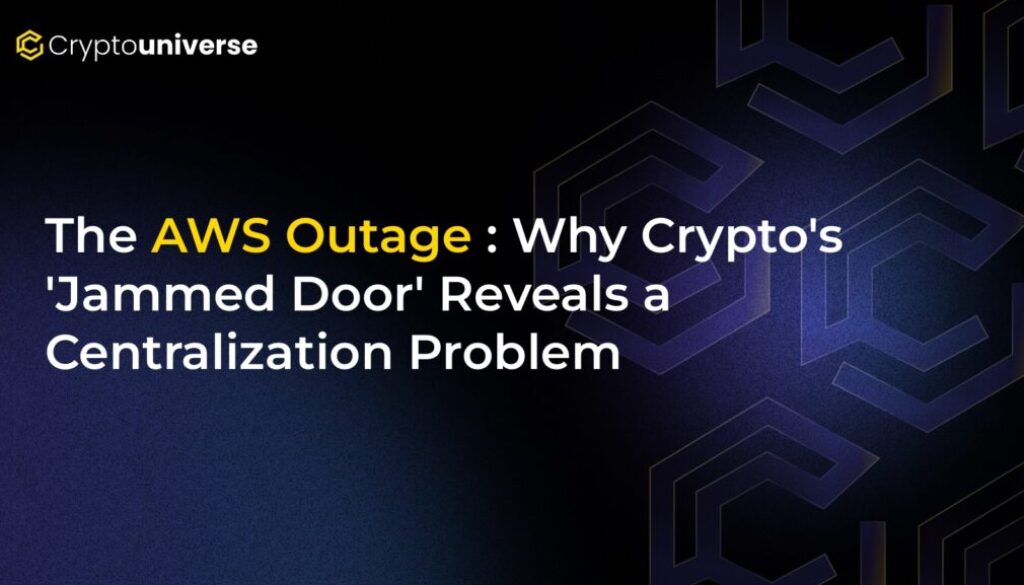The AWS Outage: Why Crypto’s ‘Jammed Door’ Reveals a Centralization Problem

The Unplugging of Web3: What Really Happened?
Recently, the digital world held its breath as a major Amazon Web Services (AWS) outage sent shockwaves across the internet. For many, it was an inconvenience. For the crypto world, it was a stark and uncomfortable reality check. Major platforms like Coinbase, MetaMask, Robinhood, and even the fintech app Venmo suddenly went dark, leaving millions of users staring at error screens and, in some unsettling cases, zero balances in their wallets.
The outage, which lasted for roughly 15 hours, caused chaos. Coinbase’s app and its Base network crashed, blocking logins and transactions. Robinhood traders faced crippling delays. MetaMask users experienced a heart-stopping glitch where their wallets appeared empty.
Yet, amidst the panic, a crucial fact emerged: the underlying blockchains, like Ethereum, never stopped. They continued to produce blocks, validate transactions, and operate exactly as designed. Users’ assets were never at risk. So, what went wrong? The incident perfectly illustrates a growing paradox in the Web3 space, best described with a simple analogy: the house was fine, but the door was jammed.
The House Was Fine, But the Door Was Jammed
Imagine your crypto assets are safely stored inside an impenetrable fortress—the blockchain. This fortress is decentralized, transparent, and always running. However, to get inside, you need a door and a key, which in the digital world is your wallet’s user interface (UI) or an exchange’s app.
The
When the AWS server hosting MetaMask’s balance-retrieval service went down, the app couldn’t display users’ funds, leading to the “zero balance” scare. The money was still there, secured on the blockchain, but the window to view it was temporarily boarded up.
Crypto’s Dirty Little Secret: A Heavy Reliance on Web2 Giants
The promise of Web3 is a decentralized internet, free from the control of single entities. The irony, however, is that much of its foundational infrastructure is built on the very Web2 giants it seeks to replace. It’s a classic case of building a new world on top of the old one’s foundations.
Industry insiders have pointed out a sobering statistic: an estimated 70% of Ethereum nodes are hosted by just three companies: AWS, Google, and Microsoft. As one blockchain CEO put it, the industry isn’t truly decentralized; it’s just “paying three different landlords instead of one.”
Why this dependence? The reasons are practical:
- Speed and Convenience: Spinning up a server on AWS is far faster and easier than building and maintaining a fully decentralized infrastructure.
- Scalability and Uptime: These hyperscalers offer incredible reliability and the ability to handle massive traffic spikes—most of the time.
- Compliance: For large, regulated entities like Coinbase, using established, compliant cloud providers is often a necessity.
This convenience, however, comes at the cost of a massive single point of failure. When one major provider has a bad day, a huge portion of the “decentralized” web goes down with it.
The Wake-Up Call: Forging a Path to True Resilience
Every major outage is a lesson, and this one was a masterclass in the importance of infrastructure. The incident has reignited a critical conversation about moving beyond a decentralized ledger to a fully distributed technology stack.
The most practical path forward appears to be a hybrid model, often called a “credible multi-home” approach. Instead of relying solely on one centralized provider, projects can distribute their workloads across multiple platforms, mixing traditional cloud services with emerging decentralized networks.
This is where the true Web3 infrastructure layer comes into play. Projects like Filecoin and Arweave for decentralized storage, or Akash for decentralized cloud computing, offer alternatives that eliminate single points of failure. By building on a combination of these systems, an application can remain online even if one provider—centralized or decentralized—experiences an issue.
Beyond the Ledger: The Future is Distributed
The AWS outage wasn’t a failure of blockchain technology; it was a powerful demonstration of its current weak spot. It served as a vital wake-up call, reminding the industry that true decentralization must extend beyond tokens and ledgers to the core infrastructure that powers user access.
The future of a resilient and genuinely decentralized Web3 won’t be defined by the blockchain alone, but by how distributed its entire ecosystem becomes—from the deepest layers of code to the final pixel on a user’s screen. This recent stumble will undoubtedly accelerate investment and innovation in building a Web3 where the house is always secure, and the door is always open.


